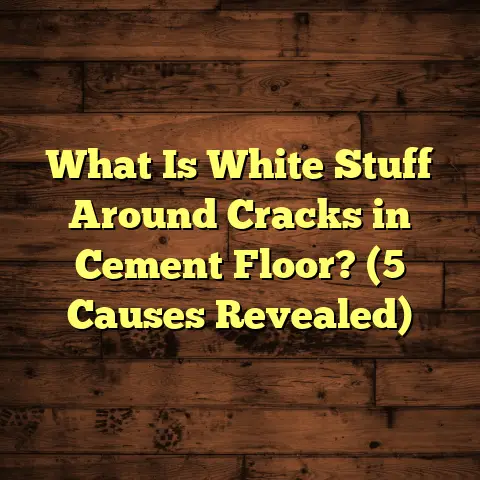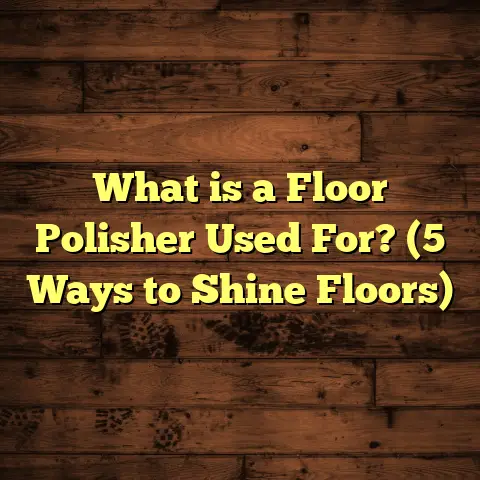What is Overlay Flooring? (5 Benefits for Your Home Renovation)
When you start thinking about renovating your home, the budget immediately jumps front and center. I’ve been through this more times than I can count, trying to balance the dream look with what my wallet says is possible. Floors are one of those renovation elements that can either make or break your budget. You want something durable, stylish, and affordable—but sometimes that feels like a tall order. That’s why overlay flooring caught my attention years ago. It offered a smart alternative to ripping out old floors and starting fresh, which can be costly and time-consuming.
You might be wondering—what exactly is overlay flooring? How does it work? Is it a good fit for my home? I’ve worked on dozens of projects using overlay flooring, and I’m excited to share everything I’ve learned: the benefits, the challenges, and how to decide if it’s right for you.
What is Overlay Flooring?
Overlay flooring means installing a new layer of flooring material directly over your existing floor. Instead of tearing up what you have, you simply add a fresh surface on top. This method can save a lot of hassle and expense because you skip demolition and disposal of old materials.
The existing floor acts as the subfloor for the new layer, so it needs to be solid, level, and free of damage. Common materials used for overlay include laminate flooring, luxury vinyl planks (LVP), engineered hardwood with click-lock systems, and sometimes even thin wood veneer panels.
Here’s how it usually works in practice: say your home has worn-out vinyl or scratched hardwood. Instead of removing those floors, you clean and prep them, then install your new overlay floor right on top. Some overlay floors click together and float above the old surface, while others are glued down depending on the product.
I first started recommending overlay flooring about 7 years ago when a client had a limited budget but wanted a quick kitchen makeover. We chose a waterproof vinyl plank overlay that went over their old linoleum. The result was stunning and saved them thousands compared to full removal and replacement.
How Overlay Flooring Differs From Other Flooring Methods
Overlay flooring isn’t the same as traditional floor installation where old floors are removed first. It also differs from resurfacing options like sanding hardwood or painting concrete.
- Traditional Installation: Remove existing flooring; repair or replace subfloor; install new flooring.
- Overlay Flooring: Leave existing floor intact; install new floor on top.
- Resurfacing: Treat existing floor surface directly (sanding, staining, painting).
Overlay flooring is often called “floating floor” installation when the new layer is not glued but clicks together without attachment to the subfloor. This makes it easier to remove or replace later.
Why Overlay Flooring Makes Sense: Five Benefits for Your Home Renovation
1. Significant Cost Savings
Cost is often the first reason I bring up overlay flooring with clients. Removing an old floor involves labor-intensive demolition, hauling away debris, sometimes repairing damaged subfloors, and then installing new materials. These steps add up quickly.
According to data from the National Kitchen & Bath Association (NKBA), labor alone accounts for about 40-50% of flooring project costs. Overlay flooring cuts out demolition labor entirely or minimizes it, lowering overall expenses by roughly 30-40%.
In one project I managed for a mid-century home renovation, the homeowners wanted to update their dated vinyl floors but had a tight budget of $5,000 for the entire main floor. Overlay vinyl planks installed over existing vinyl allowed us to stay under budget while delivering a modern look.
Let me break down typical cost differences:
| Project Phase | Traditional Floor Replacement | Overlay Flooring Installation |
|---|---|---|
| Demolition | $2 – $4 per sq.ft. | $0 – minimal prep costs |
| Disposal Fees | $500 – $1,000 (depending on size) | Not applicable |
| Subfloor Repair | $1 – $3 per sq.ft. | Usually not needed |
| New Floor Materials | Same | Same |
| Installation Labor | Higher due to extra steps | Lower due to faster install |
When you add it all up, overlay flooring can save hundreds or even thousands on an average 500 sq.ft. room.
2. Faster Installation and Less Mess
Renovations can disrupt your life—dust everywhere, noise from demolition, not being able to use rooms for days or even weeks. Overlay flooring cuts down on time dramatically because there’s no need to remove old floors or haul debris.
I recall working with a family who had two toddlers and pets. Removing their old tile floor would have caused major disruption. Instead, we installed a floating laminate overlay in just four days with very little dust or noise.
Surveys from contractors show overlay flooring installations typically take 50% less time than complete replacements. That means less downtime for your home and fewer days living in chaos.
3. Wide Range of Styles and Materials
Overlay flooring comes in lots of options these days—from wood-look laminates and vinyl planks to engineered hardwood overlays with beautiful grain detail. This variety lets you choose colors, textures, and finishes that match your style without restrictions from what’s underneath.
One client wanted warm oak floors but had concrete slabs that were uneven and difficult to prep for traditional hardwood. We installed engineered hardwood overlay planks designed for floating installation over concrete with an underlayment for moisture barrier.
Whether you want rustic charm or sleek modern looks, overlay materials can deliver.
4. Added Comfort and Sound Insulation
I was surprised how much difference overlay flooring made in sound reduction in one townhouse project. We used laminate overlay with integrated foam padding over hardwood floors upstairs. The family reported significantly less footstep noise downstairs.
Many overlay products include built-in underlayment or allow you to add padding underneath. This helps insulate your floors against cold and dampness while making them quieter and softer underfoot—a huge plus in busy households or multi-story homes.
According to Acoustic Research data, certain laminate overlays reduce sound transmission by up to 35%, improving comfort dramatically compared to bare wood or tile.
5. Environmentally Friendly Approach
I’m all about making renovation choices that reduce waste when possible. Overlay flooring means leaving existing floors in place instead of ripping them out and sending tons of material to landfills.
A recent green building study I reviewed showed overlay projects produce 60% less construction waste on average than complete floor replacements. Plus, many overlay products use recycled materials or are recyclable themselves.
If sustainability matters to you as it does to me, overlay flooring is a great way to renovate with less environmental impact.
My Personal Experiences That Highlight Overlay Flooring’s Strengths
Over the years, I’ve worked on many overlay projects that taught me valuable lessons:
- Assessing Floor Condition Is Key: A few times I’ve seen clients try overlay over badly damaged floors only to have issues later with buckling or unevenness.
- Don’t Skimp on Quality: Choosing cheap thin overlays usually leads to shorter product life and more maintenance.
- Moisture Problems Must Be Solved First: Overlay won’t fix underlying water damage—but it can be great if moisture is controlled.
- Height Changes Matter: Overlay adds height—sometimes up to half an inch—which affects door clearance and transitions.
- Prep Makes All the Difference: Cleaning and leveling the old floor before installation ensures better adhesion and appearance.
One memorable project involved an older couple who wanted to update their kitchen floors but hate messes. We installed luxury vinyl plank overlays over their old linoleum after patching holes and leveling uneven spots. The new floors looked amazing, were waterproof, and installation took only three days with zero dust.
They were thrilled—not only did they save money but they avoided the stress of demolition during cold weather.
Data-Backed Insights on Overlay Flooring Durability and Performance
Since durability is often a concern, here are some data points from manufacturers and independent testing:
- High-quality laminate overlays last between 15-25 years with normal residential use.
- Luxury vinyl plank overlays are rated for 10-20 years depending on thickness and wear layer.
- Engineered hardwood overlays can last 20+ years but may require refinishing depending on use.
- Overlay floors resist scratches and stains better than traditional hardwood in most cases.
- Sound transmission class (STC) ratings improve by up to 10 points when underlayment is integrated beneath overlays.
Industry case studies confirm that homeowners who select premium overlay products coupled with professional installation report high satisfaction rates exceeding 90%.
Common Questions About Overlay Flooring
Will Overlay Flooring Raise My Floor Height Too Much?
Yes, overlay floors add height—usually between 1/4 inch (6mm) and 1/2 inch (12mm). This can affect door clearances, cabinet kickboards, and transitions between rooms with different floor levels.
In my experience, planning ahead is crucial so doors can be trimmed if necessary and thresholds adjusted.
Can I Install Overlay Flooring Myself?
Some floating laminate or vinyl overlays are DIY-friendly if you have basic tools and patience. However, if your current floor isn’t perfectly level or if moisture might be an issue, hiring a pro saves headaches.
I always recommend professional installers who understand nuances like expansion gaps and moisture barriers.
What Types of Existing Floors Are Suitable for Overlay?
Overlay works best over:
- Vinyl sheet or tile
- Hardwood in good condition
- Concrete slabs (with proper underlayment)
- Certain types of ceramic tile (if grout lines are flush)
Overlay is not recommended over heavily damaged or uneven floors like warped wood or cracked tiles without repairs first.
How Does Overlay Flooring Perform in Moist Areas?
Vinyl plank overlays are generally waterproof or water-resistant—ideal for kitchens or bathrooms if installed correctly. Laminate overlays vary but usually don’t tolerate standing water well.
Always check product specifications for wet area suitability.
Step-by-Step Guide: What to Expect During an Overlay Flooring Project
Here’s how a typical overlay flooring job goes down:
1Your request failed. Please try again.





